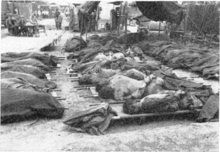| Hill 303 massacre | |
|---|---|
 Bodies of massacre victims gathered near Waegwan, South Korea, many with their hands still bound | |
| Location | Hill 303, Waegwan, South Korea |
| Coordinates | 36°00′45″N 128°24′41″E / 36.0124°N 128.4115°E |
| Date | August 17, 1950 14:00 (KST) |
| Target | U.S. Army prisoners of war |
Attack type | Summary executions |
| Deaths | 42 prisoners executed |
| Injured | 4–5 prisoners wounded |
| Perpetrators | North Korean army soldiers |
The Hill 303 massacre (Korean: 303 고지 학살 사건) was a war crime that took place during the opening days of the Korean War on August 17, 1950, on a hill above Waegwan, Republic of Korea. Forty-one United States Army (US) prisoners of war were murdered by troops of the North Korean People's Army (KPA) during one of the engagements of the Battle of Pusan Perimeter.
Operating near Taegu during the Battle of Taegu, elements of the US 2nd Battalion, 5th Cavalry Regiment, 1st Cavalry Division, were surrounded by KPA troops crossing the Nakdong River at Hill 303. Most of the US troops were able to escape, but one platoon of mortar operators misidentified KPA troops as Republic of Korea Army (ROK) reinforcements and was captured. KPA troops held the Americans on the hill and initially tried to move them across the river and out of the battle, but they were unable to do so because of a heavy counterattack. US forces eventually broke the KPA advance, routing the force. As the KPA began to retreat, one of their officers ordered the prisoners to be shot so they would not slow them down.
The massacre provoked a response from both sides in the conflict. US commanders broadcast radio messages and dropped leaflets demanding the senior North Korean commanders be held responsible for the atrocity. The KPA commanders, concerned about the way their soldiers were treating prisoners of war, laid out stricter guidelines for handling enemy captives. Memorials were later constructed on Hill 303 by troops at nearby Camp Carroll to honor the victims of the massacre.